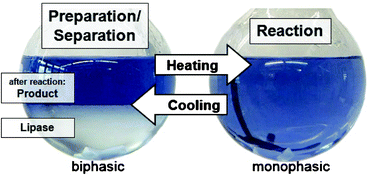An new and innovative method of free enzyme recycling from a reaction mixture has been developed which relies only on the physical properties of the reaction medium.
Biotechnology is gaining an increasing role in industrial processes, but various factors including poor industrial availability of free enzymes and efficient recycling procedures limit utilization. Common methods for enzyme recycling include immobilization of the enzyme onto a suitable support material or by encapsulation in aqueous gels. However, disadvantages of these methods include leeching of enzymes and loss of activity.

This article is free to access until the 17th November 2011! Click the link below to read more…
A liquid immobilisation concept for enzymes by thermomorphic solvent systems, Arno Behr, Leif Johnen and Bastian Daniel, Green Chem., 2011, DOI: 10.1039/C1GC15802C










